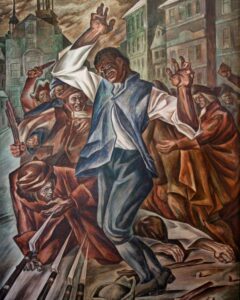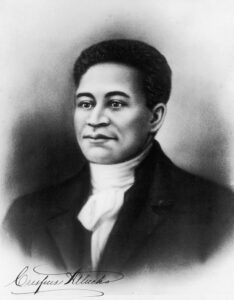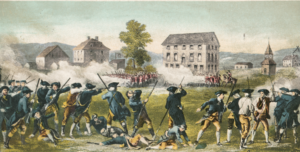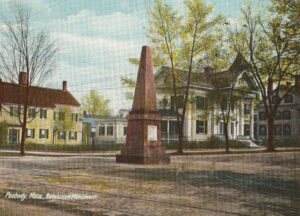February 7, 2025 | Sophia Richter | 10 minute read.
2025 and 2026 mark the 250th anniversary since the American Revolution. All over the country, you can access programming to reflect on and explore the legacies of this period in our history. For the month of February, the Peabody Historical Society & Museum will examine some of the facets of Black revolutionary history.
At the threshold of the American Revolution, American colonists were concerned that the British were being tyrannical and encroaching on their liberties and rights. Whose rights and whose liberties? What kind of future was being imagined and what kinds of changes were on the horizon? To people of African descent, both free and enslaved, who were living in Massachusetts during this period, these were important questions.

“Crispus Attucks,” by Herschel Levit, mural at the Recorder of Deeds building, built in 1943. 515 D St., NW, Washington, D.C. Library of Congress.
Whose Rights?
Among the events that elevated tensions between the British and Americans was the Stamp Act of 1756. It imposed a direct tax on colonists without the approval of the American colonial government. In Peabody (then, a part of Danvers), local leaders opposed the Stamp Act. They called for the British Parliament to repeal the tax. Concerned that these laws threatened their civil liberties, in 1768 Peabody and Danvers began to deliberate over questions of liberty and rights and to arm the local militia.
These deliberations developed into a fervor of support for the protection of civil liberties, called “natural rights”. Over the course of several meetings during the autumn of 1775 at Faneuil Hall, in Boston, Samuel Adams appealed to Bostonians:
“To what a state of infamy, wretchedness, and misery shall we be reduced if our judges shall be prevailed upon to be thus degraded to hirelings, and the Body of the People shall suffer their free Constitution to be overturned and ruined? Let not the iron hand of tyranny ravish our laws and seize the badge of freedom…and the murderous rage of lawless power be ever seen on the sacred seat of justice!”
The outcome of these meetings created the “Declaration of the Rights of Colonists”. The opening lines of this Declaration stated:
“Among the natural rights of the Colonists are these: First, a right to life; Secondly, to liberty; Thirdly, to property; together with the right to support and defend them in the best manner they can. These are evident branches of, rather than deductions from, the duty of self-preservation, commonly called the first law of nature.
All men have a right to remain in a state of nature as long as they please; and in case of intolerable oppression, civil or religious, to leave the society they belong to, and enter into another.”
During this same time, free and enslaved Black people used these “natural rights” to argue for the end of slavery, for the rights of citizenship, and, in some cases, for transportation back to Africa. Additionally, some Black men saw military service as a means of achieving these rights.
Debating the Place for Black Patriots

Public domain portrait of Crispus Attucks, artist unknown. Image from Bridgewater State College archive.
Leading up to the Revolution, many Black – free and enslaved – people served in Northern colonial militias. Famous among them is the Black soldier, Crispus Attucks. Attucks was the first man shot at the Boston Massacre on March 5, 1770. Other Black Massachusetts soldiers included Salem Poor and Peter Salem who fought at the Battle of Bunker Hill on June 17, 1775. During the years leading up to the Revolution, New England militias were largely integrated, with only the 1st Rhode Island Regiment being officially racially segregated. The majority of soldiers in Massachusetts were sailors and port workers, men accustomed to interracial labor cooperation.
But this would change as more soldiers from outside of New England joined the Continental Army. In fact, General George Washington, a slave-owner himself, initially blocked Black soldiers from enlisting. The order issued on July 10, 1774, by George Washington’s Adjutant (military officer who acts as an administrative assistant to a senior officer), General Horatio Gates, read:
“You are not to enlist any deserter from the Ministerial Army, nor any stroller, negro, or vagabond, or person suspected of being an enemy to the liberty of America, nor any under eighteen years of age.”
Why was this the case? Washington was perhaps being pragmatic for his time. In an effort to unify the thirteen colonies, Washington feared that he would lose the support of the South, whose economy depended on enslaved labor, if he allowed for a racially integrated army. Another central reason was racial prejudice. Many White colonists feared training and arming enslaved people and would have protested serving alongside men of color as equals.
Not only were Black soldiers already serving the American Revolutionary cause, but prominent White figures pushed back against these racially prejudiced orders. In a letter dated October 25, 1775 to John Adams, General John Thomas, commander of the Massachusetts troops at Roxbury stated:
“We have some negroes, but I look on them, in general, as equally serviceable with other men for fatigue; and in action many of them have proved themselves brave.”
In another case, Captain John Clouston of the Massachusetts Navy brigantine Freedom wrote a letter dated May 8, 1777 regarding two Black soldiers under his command:
“…they ship’d on board the Armed Brigantine Freedom to light agt the enemies of America & in that respect have rendered themselves worthy of the Notice of America they were volentieers in the business & ought to be considered in the same light as any other Sailors, by no means liable to be sold meerly because they are black & their masters have a property in their service.”
Despite their service and sacrifice, it wouldn’t be until April 28, 1778 that the Massachusetts legislature passed a law to formally permit Black soldiers to enlist. Between 1775 and 1783, at least 2,100 Black men from Massachusetts served as patriots of the American Revolution. By this point, municipalities also began forcing Black men to enlist in order to meet their quotas.

Painting in the American History — 1775 Collection at the New York Public Library
An Unfinished Dream
In some cases, enlisting in the Continental Army as a Black man would have opened up new possibilities to gain freedom, financial compensation, and political influence. But in many other cases, serving for the American Revolutionary cause did not change an individual Black soldier’s status.
Among the Essex County Black soldiers who fought in the Revolution, Pomp Jackson and Cato Prince gained their freedom and a pension, respectively. Meanwhile, there were instances of slave-owners who received the pensions on behalf of the Black men who enlisted. In an example, G. Johnnot of Marblehead received an:
“order for bounty coat or its equivalent in money” on behalf of his servant Romeo who enlisted in 1775 as a private in Colonel John Glover’s Marine Company.
After the Revolutionary war ended, Black soldiers were prohibited from military service once again. This was the result of the Federal Militia Acts of 1792. It wouldn’t be until 1949 that the U.S. military would make progress toward racial integration and equal rights for all soldiers. The Army would be the last service to fully racially integrate in 1954.
Being a Black soldier in the Continental Army was full of uncertainty and irony. Harriet Beecher Stowe wrote of Black men’s participation in the American Revolution thus:
“It was not for their own land they fought, not even for a land which had adopted them, but for a land which had enslaved them, and whose laws, even in freedom, oftener oppressed than protected.”
Even so, the reality of this period for Black people would have been more nuanced than this. Debates about liberty and rights would strengthen the abolitionist cause and expand the vision of freedom that White colonial Americans were calling for. In this era of revolution, these Black men not only enlisted under force or out of pragmatism. They were also likely fighting for a dream.
Honoring Peabody-Danvers Black Patriots:
If you’d like to learn more about who some of the Black soldiers of Peabody were who fought in the Revolutionary War, check out our work here: Peabody and the American Revolution
Sources:
Scholarly sources on Black Revolutionary War soldiers’ history:
Manisha Sinha, “To ‘Cast Just Obliquy’ on Oppressors: Black Radicalism in the Age of Revolution,” The William and Mary Quarterly, vol. 64, no. 1 (2007): 149-160.
Chernoh M Sesay Jr., “The Revolutionary Black Roots of Slavery’s Abolition in Massachusetts,” The New England Quarterly, vol. 87, no. 1 (March 2014): 99-131.
Kabria Baumgartner and Elizabeth Duclos-Orsello, African Americans in Essex County, Massachusetts. An Annotated Guide, (Salem Maritime National Historic Site, 2022).
Museum exhibits and articles:
“Liberty Exhibit Big Idea 6: Soldiers of African Descent in the Revolutionary War,” The Museum of the American Revolution. Accessed online: https://www.amrevmuseum.org/liberty-exhibit-big-idea-6-soldiers-of-african-descent-in-the-revolutionary-war
“Black Founders Big Idea 2: Black Soldiers and Sailors in the Revolutionary War,” The Museum of the American Revolution. Accessed online: https://www.amrevmuseum.org/black-founders-big-idea-2-black-soldiers-and-sailors-in-the-revolutionary-war
Eric G. Grundset, “African Americans of Massachusetts in the Revolution,” Sons of the American Revolution in the Commonwealth of Massachusetts, (June 20, 2013). Accessed online: https://massar.org/african-americans-of-massachusetts-in-the-revolution/
Adam E. Zielinski, “Fighting For Freedom: African Americans Choose Sides During the American Revolution,” American Battlefield Trust, (December 11, 2023). Accessed online: https://www.battlefields.org/learn/articles/fighting-freedom-african-americans-during-american-revolution#:~:text=A%20large%20portion%20of%20black,who%20joined%20the%20Continental%20Navy.
Paul-Thomas Ferguson, “African American Service and Racial Integration in the U.S. Military,” U.S. Army, (February 23, 2021). Accessed online: https://www.army.mil/article/243604/african_american_service_and_racial_integration_in_the_u_s_military
Samuel Adams, The Rights of the Colonists, The Report of the Committee of Correspondence to the Boston Town Meeting, Nov. 20, 1772. Old South Leaflets no. 173 (Boston: Directors of the Old South Work, 1906) 7: 417-428. Accessed online: https://history.hanover.edu/texts/adamss.html
“Samuel Adams: Boston’s Radical Revolutionary,” Boston National Historical Park. Accessed online: https://www.nps.gov/articles/000/samuel-adams-boston-revolutionary.htm
Troy Smith. “Battle of Saratoga.” Accessed April 3, 2024. In The Digital Encyclopedia of George Washington. Retrieved from https://www.mountvernon.org/library/digitalhistory/digital-encyclopedia/article/battle-of-saratoga/#:~:text=The%20Battle%20of%20Saratoga%20fought,career%20of%20General%20George%20Washington.
Primary Sources on Black Peabody Soldiers:
Military, Birth and Death Records, Ancestry.com
Miscellaneous Archives of the Peabody Historical Society and Museum.
Captain Samuel Flint and William Flint, by D. Webster King, Thirteenth Report of the Peabody Historical Society, 1908-1909 (Read originally April 19, 1898).
Massachusetts Soldiers and Sailors in the War of the Revolution. Prepared and Published by the Secretary of the Commonwealth, 1899.
Municipal History of Essex County, ed. Benjamin Arrington, Lewis Historical Publishing Company, 1922, pages 559 and 819.
John Wells. The Peabody Story. Essex Institute, 1972.

